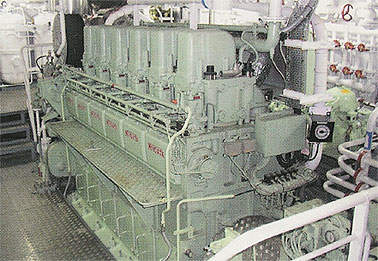The Svitzer Bristol is the first of a series of four tractor tugs built by the Spanish shipyard Astilleros Zamakona of Viscaya for the Copenhagen-based Svitzer Marine. It was designed by the Spanish naval architects Cintranaval and will work in the Avonmouth area. A second sister tug, the Svitzer Brunel, is planned for operation in Liverpool.
The Svitzer Bristol has a length of 29.5m, a breadth of 11m and a depth of 4m. It has a maximum draft of 5.9m.
Seakeeping is enhanced by its steeply sloping foredeck. Its bow is heavily protected by a fabricated rubber fender while the forward quarters and sides are also protected by strakes of moulded rubber.
DECK EQUIPMENT
A high wheelhouse is located centrally on the vessel, affording good all-round command of the vessel. The architects ensured that the exhausts were angled outwards in order not to obscure the visibility of the working deck and the winch from the wheelhouse.
On the afterdeck is a Bi Katek winch for towing. This has a split drum. Half of the drum carries 350m of 44mm diameter steel wire for towing at sea, while the other half carries 110m of synthetic fibre towline. There is also an emergency quick release hook.
The winch has a line pull of 12m/min at 30t with a holding load of 135t. Above the winch and aft of the port funnel is a Cytecma 4185c hydraulic deck crane. This is used to both handle towing gear and general store management.
On the foredeck, there is an electrically-driven windlass which is used for anchoring the tug. The deck equipment also includes a davit which can be used to launch an inflatable boat.
The vessel’s tanks contain up to 130.85m³ of fuel oil, 80m³ of ballast and 27.4m³ of fresh water. It can also carry 26.2m of foam.
The Navaids include a pair of Furuno radars, GPS, satellite compass, electronic chart display and an echo sounder. It houses GM DSS area one radios and SSB radio and the Navtex system.
The accommodation consists of four single cabins each with an additional berth for occasional use. Typically, the tug has a complement of three.
There is a Hamworthy sewage plant and a Frivasa air-conditioning system.
ENGINES AND POWER
The tug has a large engine room, which incorporates both the main and auxiliary engines. The vessel is powered by a pair of Niigata 6L28HX main engines, which run at a maximum continuous rating (MCR) of 720rpm. This produces the total of 4,087bhp.
The engines are connected to programmable Nico-Omega slipping clutches linked to a pair of azimuthing ZP-31 propulsion units – also supplied by Niigata. This gives a running speed of 12.3 knots. In operation, the tug is able to produce a bollard pull of 58.5t.
The engines additionally drive a Norgear Kumura 2FGEC/280 gearbox connected to centrifugal fire pumps. The two main fire pumps are Kvaerner Eureka systems, one with an output of 1,200m³/min and the other of 1,500m³/min. These are linked to Fischcon water foam jet nozzles located on the wheelhouse roof and remotely controlled from the wheelhouse.
Electric power is provided by a pair of 225kVA Stamford generator sets, which are powered by a Volvo TAMD 103 diesel engines running at 1,500rpm. These have an output of 415V at 50Hz. There is also a 44kVA Harbour set. The switchboards for the electrical system is forward of the propulsion system.
The tug is classified by the Lloyd’s register with the notation +100A1 TUG IWS +LMC +NMS FiFI Class 1 with Water Spray












